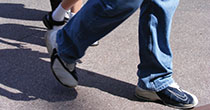Treatment of Plantar Fasciitis
by Alex MacKenzie, DC

Plantar fasciitis is a common cause of heel pain in people who spend time on their feet. The plantar fascia is a thickened band of tissue (aponeurosis) that starts at the heel (medial tubercle of the calcaneus) and runs forward to form the longitudinal arch of the foot. It provides an arch of support when standing and shock absorption when doing movements. The pain that is experienced in the bottom of your foot is often due to a breakdown of the connective tissue causing inflammation.
Plantar fasciitis is an overuse injury (usually aggravated by biomechanical factors) caused by more microtears of the plantar fascia than the body can heal. Typically, the worst pain will occur during the first few steps in the morning or at the beginning of an activity. The condition can also be aggravated toward the end of the day. Individuals with pes planus (flat feet), pes cavus (high arches), over-pronation (feet rolling in), a leg length discrepancy (short leg), excessive tibial torsion or femoral anteversion are susceptible to this condition. Patients with this condition will typically have tight and weak gastrocnemius, soleus (calve muscles), and foot muscles. This muscular weakness leads to fallen arches and poor absorption of force into the plantar fascia. This will then lead to repetitive microtrauma and pain.
In patients presenting with plantar fasciitis, history of increased weight-bearing activities is common (ie. running, walking). A physical examination will yield a point of maximal tenderness at the antereomedial region of the calcaneus (heel) and/or proximal plantar fascia (base of the toes). Passive dorsiflexion (pointing the toes up) of the toes or having them stand on their toes may also increase the patient’s pain. While it is a condition that heals on its own, in order to improve the patient’s prognosis it is important to start treating the condition as soon as possible after the onset of symptoms.
Time until resolution can be anywhere between 6 to 18 months, which can be frustrating for patients and their health-care providers. Relative rest has been found to be one of the most effective treatment strategies and includes less aggravating forms of activity. Stretching the gastroc/soleus complex and plantar fascia, strengthening the intrinsic foot muscles, and massaging the fascia are of particular importance. Such exercises may include the basic wall/stair stretch, towel toe curls or toe taps, and rolling the bottom of the foot on a ball or tube of desired material.
One study found that stretching the plantar fascia (passively pulling on toes 3 sets x 10 reps x 10 secs) showed a decrease in “pain at worst” and with the first steps in the morning. Proper shoe fitting can also play a role in treatment. Trying out a newer, thicker, well-cushioned midsole shoe may help increase shock absorption and decrease pain with long periods of walking or standing. For individuals with low arches, motion control shoes with better longitudinal arch support, arch taping, or orthotics may be suggested. Treatment of plantar fasciitis with orthotics must include control of over pronation and metatarsal head motion (especially the first metatarsal head).
For many, chiropractic adjustments of the feet and related joints (in addition to traditional approaches such as the use of ice packs and for a time avoiding the movements that seem to exacerbate the pain) may help to restore a proper range of motion, and thus remove the cause of the problem.
In conclusion, if you are suffering from foot pain, find a chiropractor or health practitioner in your local area to aid in the relief of your symptoms, and return to your daily activities pain free.
References
1. Young CC, Rutherford DS, Niedfeldt MW. Treatment of Plantar Fasciitis. Am Fam Physician. 2001;63(3): 467-74, 477-8.
2. Boddeker IR, Schafer H, Haake M. Extracorporeal shockwave therapy (ESWT) in the treatment of plantar fasciitis: a biometrical review. Clinical Rheumatology. 2001;202(5):324-30.
3. Cole C, Seto C, Gazewood J. Plantar Fasciitis: Evidence-Based Review of Diagnosis and Therapy. Am Fam Physician. 2005; 72(11):2237-42, 2247-8.
Dr. Alex MacKenzie began his journey as a baseball player for Team Ontario where he found his passion for improving and pushing the level of the human potential. He then attended Canisius College, an NCAA Division I school, where he continued toward his goals of professional baseball. An injury along his journey brought him to chiropractic care where he discovered his new passion. Dr. Mackenzie graduated from the Canadian Memorial Chiropractic College and has since decided to aid athletes in avoiding common injuries and performing at the next level. He practices an evidence-based, functional, and a diversified model of care, complementing his individualized patient care with specific mobility and exercise performance. He strives to empower and educate his patients to take an active role in their health and has a passion for treating patients with a strong desire to improve their own overall health, well-being, and performance goals. See the colour display ad on page 14 of the 19.6 March/April issue of the WHOLifE Journal. |
